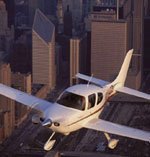 As a baseball fan it's tough to hear about the crash of Yankee pitcher Cory Lidle today. It certainly puts a cloud over the playoffs, of which I'm still interested mainly because the St. Louis Cardinals remain in the mix. Their game with the Mets was rained out today.
As a baseball fan it's tough to hear about the crash of Yankee pitcher Cory Lidle today. It certainly puts a cloud over the playoffs, of which I'm still interested mainly because the St. Louis Cardinals remain in the mix. Their game with the Mets was rained out today.The rain-out alone says something about the weather around New York today. Heavy rain was moving across the area and flying conditions were not pristine. Here's a look at the weather at LaGuardia Airport around the time in question:
KLGA 112110Z 06010KT 2 1/2SM RA FEW009 OVC019 17/14For those who aren't pilots or weathermen the above gibberish means the horizontal visibility was ranging from 1 1/2 to 2 1/2 miles in moderate to heavy rain, and the vertical cloud height was averaging anywhere from 1600 feet to 3900 feet with scattered 'scud' clouds from 700 to 900 feet.
KLGA 112059Z 06011KT 2SM RA FEW009 OVC019 17/14 A2984
KLGA 112051Z 07010KT 1 3/4SM RA BKN019 OVC025 17/14 A2985
KLGA 112038Z 08011KT 1 3/4SM RA BKN016 OVC022 17/14 A2985
Speculation, like talk, is cheap, but weather certainly has to be looked at, especially in light of the following:
Lidle earned his pilot's license in February and bought the plane he was flying in September.Whether he was an "IFR" rated pilot (capable of flying in bad weather) will come out later, but for someone who just earned their license in February, it's doubtful.
As to fuel troubles, that's a little hard to fathom since the plane had not been up very long. However, airplanes have wing-laden fuel tanks that can sometimes cause confusion as to swapping from one tank to the next. Planes have been known to crash due to fuel starvation with adequate fuel in one of the tanks.
Ironically the Cirrus SR20 is equipped with a parachute system, but at the altitude they were flying it would have done no good.
Altogether a terrible tradegy. God be with the families at this time.
MORE 10/11/06
More information is coming out. Lidle was not IFR-rated, but was supposedly going to practice that kind of flying with his instructor this week. The plane was only up for 12 minutes, and never got above 800 feet.
From looking at the times my intial listing of weather reports was wrong. The flight left Teterboro, NJ around 2:30 pm EDT, which is 18:30 GMT. Here are the reports:
KLGA 111951Z 10011KT 8SM -RA OVC018 18/13 A2987 RAB46Here's the weather at Teterboro Airport around takeoff time:
KLGA 111851Z 10013KT 9SM OVC018 18/13 A2988
KLGA 111751Z 10011KT 9SM OVC018 18/13 A2991
KTEB 111851Z 08007KT 7SM OVC019 17/13 A2987Both are considered "Marginal VFR" and certainly something the pilots should have been able to handle based on their altitude of 800 feet. In "Class B" airspace VFR flight requires a pilot to be "clear of clouds".
KTEB 111751Z 09007KT 7SM OVC017 17/12 A2990
So from the weather reports it looks like they followed all the rules, at least as long as the flight wasn't going to last very long. It's evident from the reports the conditions rapidly deteriorated shortly after the crash as the rain approached.
If weather wasn't a factor (presuming there wasn't an unusual visibility situation along the East River and not at the airports) it makes the crash all the more bizarre, since one might think they'd try to put it down in the river if there were fuel or other problems. But as I said in the opening post (and from what I've basically proven here) talk and speculation are cheap. That's why we have an NTSB.
MORE 10/12/06
Avweb has a synopsis of the airspace on Lidle's flight path:
The VFR airspace beneath the Class B follows the river at 11-hundred feet and below, ending (dropping to the surface) north of the crash site. The VFR airspace in that area might be described as a box canyon with a roof. The corridor (and river) is roughly 2,000 feet wide, contains five bridges, Roosevelt Island, has tall buildings on both sides and often includes helicopter and sometimes seaplane traffic. Winds were reported ENE at 13, with gusts to 22. Witness reports suggest that the airplane had made a u-turn to the left from a northern heading.It's unlikely Lidle wanted to enter the Class B controlled airspace at the north end of the East River, therefore he needed to execute a left 180 degree U turn at some point. Once again weather has to be considered, since winds were from the east gusting to 22 knots at the surface. At an altitude of 800-1000 feet the winds might have been 10 knots higher. That would have placed a sudden tailwind on the aircraft as soon as it banked towards the west, in turn increasing its speed across the ground, and making a potential left turn wider than expected. Still just idle speculation at this point.
Regardless of what the probable cause will be, flying is still a safe pursuit and obviously Lidle had fallen in love with it. Hopefully this accident won't dissuade others from the hobby nor generate draconian restrictions on private flight.

No comments:
Post a Comment